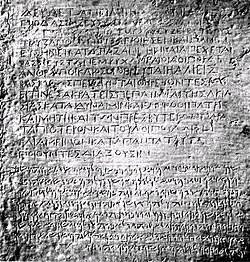
Back Édit bilingue de Kandahar French कान्धार का द्विभाषी शिलालेख Hindi Grieks-Aramese inscriptie van Kandahar Dutch د کندهار دوه ژبی ډبرلیک Pashto/Pushto காந்தார இருமொழிக் கல்வெட்டு Tamil
| Kandahar Bilingual Rock Inscription (Kandahar Edict of Ashoka) | |
|---|---|
 Bilingual inscription of Ashoka in Greek (top) and Aramaic (bottom) in Afghanistan | |
| Material | Rock |
| Height | 55 cm (22 in)[1] |
| Width | 49.5 cm (19.5 in)[1] |
| Writing | Greek and Aramaic |
| Created | c. 260 BCE |
| Period/culture | Mauryan |
| Discovered | 1958 (31°36′56.3"N 65°39′50.5"E) |
| Place | Chehel Zina, near Kandahar, Afghanistan |
| Present location | Kabul Museum (cast) |
Location within Afghanistan | |
The Kandahar Bilingual Rock Inscription, also known as the Kandahar Edict of Ashoka and less commonly as the Chehel Zina Edict, is an inscription in the Greek and Aramaic languages that dates back to 260 BCE and was carved by the Mauryan emperor Ashoka (r. 268–232 BCE) at Chehel Zina, a mountainous outcrop near Kandahar, Afghanistan. It is among the earliest-known edicts of Ashoka, having been inscribed around the 8th year of his reign (c. 260 BCE), and precedes all of his other inscriptions, including the Minor Rock Edicts and Barabar Caves in India and the Major Rock Edicts.[2] This early inscription was written exclusively in the Greek and Aramaic languages. It was discovered below a 1-metre (3.3 ft) layer of rubble in 1958[1] during an excavation project around Kandahar,[3] and is designated as KAI 279.
It is sometimes considered to be a part of Ashoka's Minor Rock Edicts (consequently dubbed "Minor Rock Edict No. 4"),[4] in contrast to his Major Rock Edicts, which contain portions or the totality of his edicts from 1–14.[5] The Kandahar Edict of Ashoka is one of two ancient inscriptions in Afghanistan that contain Greek writing, with the other being the Kandahar Greek Inscription, which is written exclusively in the Greek language.[1] Chehel Zina, the mountainous outcrop where the edicts were discovered, makes up the western side of the natural bastion of the ancient Greek city of Alexandria Arachosia as well as the Old City of modern-day Kandahar.[6]
The edict remains on the mountainside that it was discovered on. According to the Italian archaeologist Umberto Scerrato, "the block lies at the eastern base of the little saddle between the two craggy hills below the peak on which the celebrated Cehel Zina of Babur are cut".[3] A cast of the inscription is present in the National Museum of Afghanistan in Kabul.[7] In the Kandahar Edict, Ashoka, a patron of Buddhism, advocates the adoption of piety (using the Greek-language term Eusebeia for the Indian concept of Dharma) to the Greek community of Afghanistan.[8]
- ^ a b c d Dupree, L. (2014). Afghanistan. Princeton University Press. p. 286. ISBN 9781400858910. Retrieved 27 November 2016.
- ^ Valeri P. Yailenko Les maximes delphiques d'Aï Khanoum et la formation de la doctrine du dharma d'Asoka (in French). Dialogues d'histoire ancienne vol.16 n°1, 1990, pp. 243.
- ^ a b Scerrato, Umberto (1958). "An inscription of Aśoka discovered in Afghanistan The bilingual Greek-Aramaic of Kandahar". East and West. 9 (1/2): 4–6. JSTOR 29753969.
The block, brought to light during some excavation works, is an oblong mass of limestone covered by a compact dark-grey coating of basalt. It lay, below a layer of rubble about one metre high, a few yards up the road that passes through the ruins of the city. It is situated NE-SW and measures approximately m. 2.50x1. In the centre of the much inclined side, looking towards the road there is a kind of trapezoidal tablet, a few centimetres deep, the edges being roughly carved.
- ^ Sircar, D. C. (1979). Asokan studies. p. 113.
- ^ For exact translation of the Aramaic see "Asoka and the decline of the Maurya" Romilla Thapar, Oxford University Press, p.260 [1] Archived 17 May 2017 at the Wayback Machine
- ^ Une nouvelle inscription grecque d'Açoka, Schlumberger, Daniel, Comptes rendus des séances de l'Académie des Inscriptions et Belles-Lettres Année 1964 Volume 108 Numéro 1 pp. 126-140 [2]
- ^ "Kabul Museum" (PDF). Archived from the original (PDF) on 28 November 2016. Retrieved 27 November 2016.
- ^ Notes on the Kandahar Edict of Asoka, D. D. Kosambi, Journal of the Economic and Social History of the Orient, Vol. 2, No. 2 (May, 1959), pp. 204-206 [3]
© MMXXIII Rich X Search. We shall prevail. All rights reserved. Rich X Search

